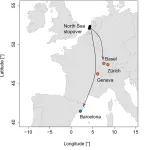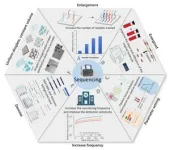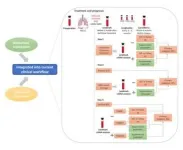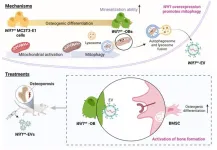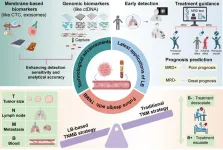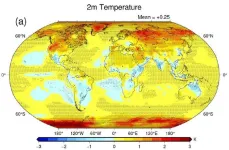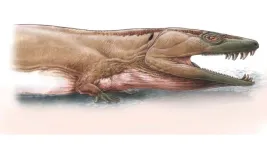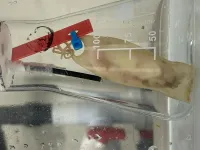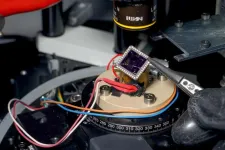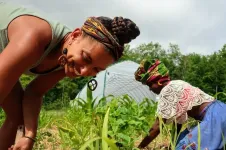(Press-News.org) Young, naïve starlings are looking for their wintering grounds independently of experienced conspecifics. Starlings are highly social birds throughout the year, but this does not mean that they copy the migration route from each other. By revisiting a classic ‘displacement’ experiment and by adding new data, a team of researchers at the Netherlands Institute of Ecology (NIOO-KNAW) and the Swiss Ornithological Institute (Vogelwarte Sempach) have settled a long-lasting debate. Their findings are now published in the scientific journal Biology Letters.
The question of how migratory birds locate their migration routes has intrigued mankind for centuries. Biologist Albert Perdeck from the Netherlands aimed to find answers when he displaced thousands of migrating starlings by plane from the Netherlands to Switzerland and Spain in the 1950’s and 1960’s. This experiment has become a classic study on the migratory orientation of birds. Now, seventy years later, colleagues have confirmed his findings and were able to solve a long-lasting scientific debate using this historical dataset.
Young vs. adult
The birds were individually recognisable using light-weight metal leg rings with a unique code – a method used by the Dutch Centre for Avian Migration and Demography, Vogelwarte Sempach and European partners until this day. Ring recoveries indicated that relocated young and adult starlings used different strategies to reach the winter destinations in the British Isles and France. “Adult starlings were aware of this move and adjusted their migratory orientation to reach their normal wintering areas,” according to Morrison Pot at the NIOO-KNAW. “Young starlings continued in a south-westerly direction – the direction they would have chosen when departing from the Netherlands – and reached ‘wrong’ destinations in southern France and Spain.”
New friends?
Over the years, experts in the field of avian migration have been divided about the interpretation of Perdeck’s results. Pot: “Starlings are highly social animals and, according to some experts, the relocated young starlings may just as well have joined a flock of local conspecifics.” The relocated starlings would have copied the migratory behaviour of their new friends showing them where to go. “If true, the migratory route is largely learned instead of inherited.” A major difference.
The team of researchers retrieved the historical data of Perdeck’s displacement experiments in the paper archives of the Dutch Centre for Avian Migration and Demography and compared the migratory orientation with the migratory behaviour of local Swiss and Spanish starlings. “The latter data were retrieved from institutional archives, but were unavailable in Perdeck’s days.”
Social migrants
By re-analysing this historical dataset, the team showed that the migratory orientation of the relocated starlings differed from the local conspecifics. Starlings are thus no social migrants or ‘copycats’. The alternative social explanation of Perdeck’s results has thus been debunked. As explained by Pot: “Starlings travel independently and decisions about where to go are not overruled by the migratory behaviour of others.” Recently, a study in collaboration with Vogelwarte Sempach showed that starlings migrate at night. This is in line with the 70-year-old findings, because how would you follow someone in the pitch darkness of the night?
Times of change
Learned or inherited behaviour, why does it matter? “In times of rapid changes in global climate and land-use, it is of great importance to understand whether migratory behaviour is largely inherited or learned,” says lead scientist and head of the Dutch Centre for Avian Migration and Demography Henk van der Jeugd. Inherited behaviours are less flexible to rapid change. “Although starlings are numerous and widespread birds that have adjusted to human dominated landscapes, their migratory behaviour is likely less flexible.”
With more than 200 staff members and students, the Netherlands Institute of Ecology (NIOO-KNAW) is one of the largest research institutes of the Royal Netherlands Academy of Arts and Sciences (KNAW). The institute specialises in water and land ecology with three major themes: biodiversity, climate change and the sustainable use of land and water. The institute is located in an innovative and sustainable research building in Wageningen, the Netherlands. NIOO has an impressive research history that stretches back 70 years and spans the entire country, and beyond.
END
Migrating starlings are no copycats
70-year-old research question finally answered
2024-07-05
ELSE PRESS RELEASES FROM THIS DATE:
Osteoblast-derived extracellular vesicles exert bone formation effects by WIF1-mediated regulation of mitophagy
2024-07-05
Osteoporosis is a common disorder, especially in the elderly, characterized by bone loss and increased fracture risk. Treatments target abnormal osteoclast activity but face adherence issues. The disease disrupts the balance between bone resorption and formation. Key factors like Wnt signaling and mitochondrial health influence osteoblast differentiation. However, WIF1's role in regulating mitophagy and osteoblast differentiation remains unclear.
This research investigated the role of WIF1 in controlling the osteogenic differentiation stage of the OB precursor cell line (MC3T3-E1 cells) and assessed ...
Based on the improvement of detection technology, a new summary is proposed for the application of liquid biopsy, future clinical trial design and patient management of NSCLC
2024-07-05
This study was led by Kezhong Chen (Department of Thoracic Surgery, Peking University People’s Hospital & Peking University People’s Hospital Thoracic Oncology Institute). In clinical practice, traditional tumor-node-metastasis (TNM) staging had difficulty achieving accuracy in prognosis stratification at the individual patient level. Researchers therefore proposed to introduce blood minimal residual disease (MRD) status and proposed a new tumor-node-metastasis-blood (TNMB) staging system to more accurately and individually define the postoperative status of lung cancer patients (Fig. 1).
LB, well known for its noninvasiveness, easy accessibility, ...
Experts show how resilience to Alzheimer’s differs by sex and gender
2024-07-05
An international panel of experts led by the Barcelona Institute for Global Health (ISGlobal), a centre supported by the “la Caixa” Foundation, under the umbrella of the Alzheimer's Association International Society to Advance Alzheimer's Research and Treatment, has produced a consensus statement on sex and gender disparities in resilience to Alzheimer's disease and call for incorporating these differences in future research. The work has been published in Alzheimer's & Dementia: The Journal of the Alzheimer's Association.
Women make up the majority of people with Alzheimer's ...
Exploring the radiative effects of precipitation on arctic amplification and energy budget
2024-07-05
One of the key metrics for climate modelling is radiative forcing. Most climate models, including the general circulation models (GCMs), focus on the effects of different atmospheric factors on radiative forcing. However, there are still large uncertainties in satellite observations and multi-model simulations associated with some atmospheric factors. Among them, clouds are a known source of uncertainty in GCMs, leading to radiative biases. However, another possible source of radiative uncertainty is associated with precipitation.
In principle, precipitating particles affect radiative forcing by disrupting incoming shortwave and outgoing longwave radiations. ...
Insilico delivers second preclinical candidate compound (PCC) to Fosun Pharma
2024-07-05
Insilico Medicine(“Insilico”), a clinical-stage generative artificial intelligence (AI)-driven drug discovery company, has successfully delivered the second preclinical candidate compound (PCC) in its collaboration with Fosun Pharma in June 2024, a potential innovative therapeutic using synthetic lethal strategy for the treatment of solid tumors. Insilico expects to submit the pre-IND application for this candidate with the CDE in 2024 Q4.
When initiating the collaboration, Fosun Pharma proposed four targets of interest, and the target of the PCC nominated in this program is one of them and plays a critical role in DNA damage repair mechanisms. Insilico’s ...
Gondwana’s ultimate hunter – New giant fossil tetrapod found in Namibia
2024-07-05
After three years of meticulous study, an international team of researchers has announced the discovery of a fossilised giant basal tetrapod in Namibia's arid heartland in Nature. A basal tetrapod is an early four-legged vertebrate with fingers and toes, which lived during the transition from water to land. These ancient carnivores are among the earliest ancestors of all modern animals. This nearly complete 3-meter-long skeleton of an adult, unearthed in the Ugab River valley in Damaraland, is the largest ever discovered. This discovery is significant because it challenges previous assumptions that these early four-legged vertebrates, which lived during ...
Offshore windfarms – A threat for electro-sensitive sharks?
2024-07-05
An ongoing research project into the impact of offshore windfarm electromagnetic fields on shark development reveals that the alternating electric currents produced by underwater windfarm cables seems not to disrupt the growth or survival of sharks.
Offshore windfarms are one of the most common marine renewable energy (MRE) producers, and are seen as a pivotal technology in the global transition towards renewable energy and away from fossil fuels that contribute to climate change.
However, their proliferation in marine environments raises new questions about their impacts on wildlife. Energy operators and ...
A 2D device for quantum cooling
2024-07-05
To perform quantum computations, quantum bits (qubits) must be cooled down to temperatures in the millikelvin range (close to -273 Celsius), to slow down atomic motion and minimize noise. However, the electronics used to manage these quantum circuits generate heat, which is difficult to remove at such low temperatures. Most current technologies must therefore separate quantum circuits from their electronic components, causing noise and inefficiencies that hinder the realization of larger quantum systems beyond the lab.
Researchers in EPFL’s Laboratory of ...
MIT engineers find a way to protect microbes from extreme conditions
2024-07-05
Microbes that are used for health, agricultural, or other applications need to be able to withstand extreme conditions, and ideally the manufacturing processes used to make tablets for long-term storage. MIT researchers have now developed a new way to make microbes hardy enough to withstand these extreme conditions.
Their method involves mixing bacteria with food and drug additives from a list of compounds that the FDA classifies as “generally regarded as safe.” The researchers identified formulations that help to stabilize several different types ...
Why the U.S. food system needs agroecology
2024-07-05
Agroecology—a science, practice, and movement which seeks social, political, economic, and environmental sustainability in the global food system—is gaining momentum in the U.S., according to a new Dartmouth-led commentary in Nature Food. As the co-authors report, the approach requires coordination between scientists, farmers, and activists.
"When it comes to sustainable food and agriculture, people in the U.S. tend to be more familiar with organic farming, the production of food without synthetic inputs, and regenerative agriculture, which primarily strives to restore soil health," says lead author Theresa Ong, an assistant professor of environmental studies ...
LAST 30 PRESS RELEASES:
Numbers in our sights affect how we perceive space
SIMJ announces global collaborative book project in commemoration of its 75th anniversary
Air pollution exposure and birth weight
Obstructive sleep apnea risk and mental health conditions among older adults
How talking slows eye movements behind the wheel
The Ceramic Society of Japan’s Oxoate Ceramics Research Association launches new international book project
Heart-brain connection: international study reveals the role of the vagus nerve in keeping the heart young
Researchers identify Rb1 as a predictive biomarker for a new therapeutic strategy in some breast cancers
Survey reveals ethical gaps slowing AI adoption in pediatric surgery
Stimulant ADHD medications work differently than thought
AI overestimates how smart people are, according to HSE economists
HSE researchers create genome-wide map of quadruplexes
Scientists boost cell "powerhouses" to burn more calories
Automatic label checking: The missing step in making reliable medical AI
Low daily alcohol intake linked to 50% heightened mouth cancer risk in India
American Meteorological Society announces Rick Spinrad as 2026 President-Elect
Biomass-based carbon capture spotlighted in newly released global climate webinar recording
Illuminating invisible nano pollutants: advanced bioimaging tracks the full journey of emerging nanoscale contaminants in living systems
How does age affect recovery from spinal cord injury?
Novel AI tool offers prognosis for patients with head and neck cancer
Fathers’ microplastic exposure tied to their children’s metabolic problems
Research validates laboratory model for studying high-grade serous ovarian cancer
SIR 2026 delivers transformative breakthroughs in minimally invasive medicine to improve patient care
Stem Cell Reports most downloaded papers of 2025 highlight the breadth and impact of stem cell research
Oxford-led study estimates NHS spends around 3% of its primary and secondary care budget on the health impacts of heat and cold in England
A researcher’s long quest leads to a smart composite breakthrough
Urban wild bees act as “microbial sensors” of city health.
New study finds where you live affects recovery after a hip fracture
Forecasting the impact of fully automated vehicle adoption on US road traffic injuries
Alcohol-related hospitalizations from 2016 to 2022
[Press-News.org] Migrating starlings are no copycats70-year-old research question finally answered
